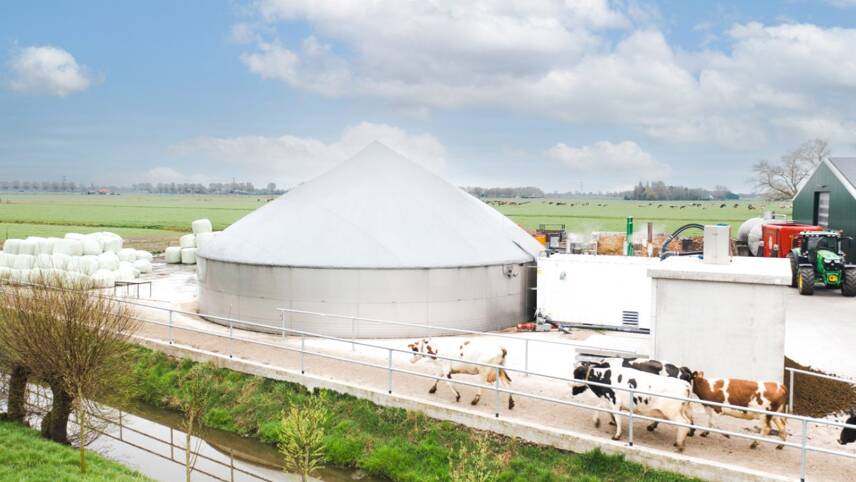Register for free and continue reading
Join our growing army of changemakers and get unlimited access to our premium content

Pictured: A manure digester at a dairy farm in the Netherlands. Image: Yaron Bindels for Ben & Jerry's
The Brand has today (9 May) announced the launch of the pilot project, dubbed ‘Mootopia’, across 15 of its supplier farms. Seven of the farms are in the US and eight are in the Netherlands. The overarching aim is to bring the emissions intensity of the farms to a level that is half of the US industry average by the end of 2024.
Under ‘Mootopia’, the dairy farms will be supported to adopt regenerative agriculture practices for growing grass and other feed crops. Regenerative methods purport to improve soil quality, thus enabling the soil to draw down more carbon. Additionally, they result in lower use of resources such as commercial fertilizers. Ben & Jerry’s has received $9.3m from parent corporation Unilever to scale regenerative practices on dairy farms, as part of Unilever’s €1bn climate and nature fund.
Farms will also be asked to use a greater percentage of home-grown feed, as feed that has had to travel long distances comes with a greater embodied emissions footprint.
Additionally, farms will be supported to reduce methane emissions from cows by giving them rumen modifiers that act as digestive aids. These additives inhibit methanogenesis – the formation of methane by microbes. One of the innovations set to be trialled is a red-seaweed-based supplement from start-up Blue Ocean Barns. This supplement purports to reduce methane emissions from cow burps by some 80%.
The other major facet of the ‘Mootopia’ scheme is reducing emissions from manure management. Farmers will be supported to put manure through digesters and separators, reducing emissions and creating resources such as energy and fertilizer.
Learnings from ‘Mootopia’ will be used to inform Ben & Jerry’s’ approach to reducing emissions across its global dairy supply chains.
“This approach to dairy farming could be a game-changer,” said the brand’s global sustainability manager Jenna Evans. “It has the potential to make a meaningful reduction in emissions on dairy farms and help fight the worst effects of climate change. All of us, especially businesses, must take action before it’s too late and the climate crisis makes our world uninhabitable.”
The Intergovernmental Panel on Climate Change’s (IPCC) two 2022 reports revealed that half of the global population is already ‘highly vulnerable’ to the physical impacts of the climate crisis, with one-third facing an ‘unliveable’ future in a business-as-usual scenario. The best chance of mitigating these risks is by bringing global emissions to net-zero or beyond by 2050 at the latest. Delivering this level of emissions reductions will require an overhaul of the fossil-fuel-based global energy system, but will also require behavioural changes – including changes to diets.
Analysis of the IPCC reports by investor coalition FAIRR concluded that the ongoing climate and nature crises could wipe 7% off of the value of the global dairy sector by 2050.
Footprint forecast: Dairy or plant-based?
Dairy ingredients account for more than half of Ben & Jerry’s’ overall emissions footprint. As such, reducing dairy supply chain emissions will be crucial if the brand is to meet its climate targets. The brand has committed to reaching net-zero Scope 1 (direct) and Scope 2 (power-related) emissions by 2025. To prevent over-reliance on offsetting and to ensure the supply chain is accounted for, Ben & Jerry’s has also committed to reducing the emissions intensity of all products by 40% by 2025, against a 2015 baseline. The Science-Based Targets Initiative (SBTi) has approved these targets in line with 1.5C.
WWF has previously stated that, while many dairy farmers see the net-zero transition as a major challenge, most large dairy farms in the US could reach net-zero by 2025 and would likely see financial benefits from doing so.
However, not all organisations are so supportive of dairy’s role in a net-zero world. Arla received criticism from several green groups after launching its recent ‘don’t cancel the cow’ campaign, which poked argument with consumers who opted for plant-based dairy alternatives over environmental concerns. Despite the sentiment of the campaign, Arla is investing in plant-based products alongside dairy.
The UK’s Climate Change Committee (CCC) estimates that red meat and dairy consumption will need to be 20% lower in 2050 than it was in 2019, on a per-capita basis, if the national net-zero target is to be delivered. The National Food Strategy White Paper went a step further and recommended a 33% reduction within this timeframe.
Ben & Jerry’s, like many brands, is looking to plant-based products as well as working on lower-emission dairy. It launched its first vegan tubs in 2016 and now offers dairy-free versions of more than a dozen products.


While methane (CH4) emissions from cattle and organic waste is a powerful greenhouse gas that breaks down into carbon dioxide (CO2) in the atmosphere, it should be remembered that this CO2 was first captured recently by the plants (eg grass) that cattle consume that grew using solar energy, so it is a circular economy that should not be confused with producing CO2 from burning fossil fuels of coal, oil and gas. Allowing this biomethane to escape is a waste of the solar energy that produced the plants, so all organic waste should be processed in an anaerobic digester to capture its energy, rather than burning it which produces harmful nitrogen oxides (NOx)